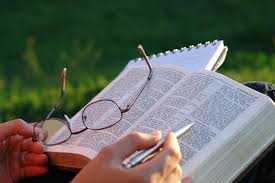Lectio Divina
This traditional way of praying scripture has become popular in a number of Christian churches. I think it began in monasteries, where monks sat at their evening meal, listening to the reading of the day. When a verse or phrase had meaning for a monk, he would leave the table and take the words to his cell for evening prayer. The lector would read the same scripture over and over until the last monk left the room.
A form of lectio divina is used with people on retreats. We call it ‘listening prayer’. There is preparation for it, a quietening of mind and body, a gentle settling of the distractions that rise like dust to obscure the beautiful light in the heart. Lectio divina is not a part of a programme or presentation. It has its own unhurried space. We have a Bible, and usually, a lit candle.
 Another aspect of preparation is awareness of the way praying with scripture works. It is an unwrapping process, a bit like the game ‘pass the parcel’, each layer producing some new gift. Generally, there are four layers, four stages, although this can vary. It is impossible to place any kind of formula on the work of the Spirit of Jesus. The journey is from head to heart and sometimes a person will be taken directly to the heart space. For the rest of us, it can work like this:
Another aspect of preparation is awareness of the way praying with scripture works. It is an unwrapping process, a bit like the game ‘pass the parcel’, each layer producing some new gift. Generally, there are four layers, four stages, although this can vary. It is impossible to place any kind of formula on the work of the Spirit of Jesus. The journey is from head to heart and sometimes a person will be taken directly to the heart space. For the rest of us, it can work like this:
Information comes first
We have the expectation that we’ll receive a gift from this reading, so we listen to every detail, noting anything that connects with us. That connection usually comes as some kind of feeling. What happens in our body while we are listening? For example, the reading may be from Mark 1: 10-20, where Jesus calls Simon and Andrew and then James and John. I feel a movement within me as I pick up on the immediacy in the passage- ‘at once’ they left their nets. ‘At once’ they followed Jesus.
The second stage is allegorical
The story now becomes parable for the present moment. It’s about Jesus choosing to work with and through community today, and about our response to him. There comes awareness of the varied ways Jesus calls, teaches and heals in the church.
The third stage is personal interpretation
The words ‘at once’ were like small pebbles thrown, making me flinch. What did that mean? Have I been slow to respond, sometimes deaf? I sit with that for a while, asking God for clarity.
The fourth stage is wordless prayer
This is the deepest part of lectio divina where we let go of ideas and judgements. Even the words of scripture rest in silence. There is an inner quiet born of emptiness and often a feeling of great spaciousness as though there are no boundaries to the heart.
It is difficult to describe the end result of lectio divina because it is non-personal and beyond language. It is a place of Oneness where paradox makes perfect sense.
It is another form of holy communion and the response is profound gratitude.

 Entries(RSS)
Entries(RSS)